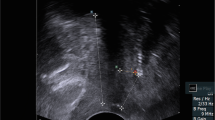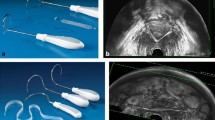Abstract
Introduction and hypothesis
This study aims to assess the role of the introital ultrasound in the evaluation of patients with low urinary tract symptoms after sling surgery for incontinence.
Methods
From 2000 till 2007, a total of 31 patients underwent sub-urethral tape placement for stress urinary incontinence and developed thereafter lower urinary tract symptoms. The urological evaluation consisted of a detailed medical history, a urogynecologic examination, a complete urodynamic exam, a measurement of the post-void residue, and an introital ultrasound. All patients filled up the MHU (Mesure du Handicap Urinaire) questionnaire. These patients had a transvaginal tape lysis under local anesthesia. We correlated the ultrasound findings with postoperative clinical success and failure.
Results
Thirty-one patients with low urinary tract symptoms (LUTS) secondary to sling placement underwent a tape lysis. Median age was 63.1 ± 10.9 years, and the median time between the anti-incontinence surgery and the tape lysis was 21.5 ± 16.2 months. Seven patients had only obstructive symptoms, 15 patients had obstructive and overactive bladder symptoms, and nine patients had overactive bladder symptoms. Introital ultrasound revealed an abnormality of the tape in 26 patients. Ten patients had a position abnormality, five patients had a urethral distortion by the tape, and 11 patients had the previous two abnormalities.
After tape lysis, the obstructive symptoms disappeared in 19 out of 22 patients (86%), and the overactive bladder symptoms disappeared in 16 out of 24 patients (66%).
In case of ultrasound anomaly, the tape lysis was efficient in 23 out of 26 patients (89%), while in the absence of ultrasound anomaly (five patients) the tape lysis was not useful in treating LUTS in all patients.
Conclusion
Ultrasonography is a useful tool in investigating postoperative lower urinary tract symptoms and in the selection of patients who will benefit from tape lysis.


Similar content being viewed by others
References
Petros PE, Ulmsten UI (1993) An integral theory and its method for the diagnosis and management of female urinary incontinence. Scand J Urol Nephrol Suppl 153:1–93
Bourrat M, Armand C, Seffert P, Tostain J (2003) Complications et résultats fonctionnels à moyen terme du TVT dans l’incontinence urinaire d’effort. Prog Urol 13:1358–1364
Grise P, Lobel B, Grall J (2003) Les complications du TVT. Prog Urol 13:144–146
Hermieu JF (2003) Complications de la technique TVT. Prog Urol 13:459–465
Latthe PM, Foon R, Toozs-Hobson P (2007) Transobturator and retropubic tape procedures in stress urinary incontinence: a systematic review and meta-analysis of effectiveness and complications. BJOG 114:522–531
Mouracade P, Lang H, Jacqmin D, Saussine C (2008) Transvaginal tape lysis for urinary obstruction after suburethral tape placement. When to do an immediate replacement? Int Urogynecol J Pelvic Floor Dysfunct 19(9):1271–1274
Salin A, Conquy S, Elie C, Touboul C, Parra J, Zerbib M et al (2007) Identification of risk factors for voiding dysfunction following TVT placement. Eur Urol 51:782–787
Alperin M, Abrahams-Gessel S, Wakamatsu MM (2008) Development of de novo urge incontinence in women post sling: the role of preoperative urodynamics in assessing the risk. Neurourol Urodyn 27(5):407–411
Cross CA, Cespedes RD, English SF, Mcguire EJ (1998) Transvaginal urethrolysis for urethral obstruction after anti-incontinence surgery. J Urol 159:1199–1201
Segal JL, Vassallo B, Kleeman S, Silva WA, Karram MM (2004) Prevalence of persistent and de novo overactive bladder symptoms after the tension-free vaginal tape. Obstet Gynecol 104:1263–1269
Nilsson CG, Kuuva N, Falconer C et al (2002) Long-term results of the tension-free vaginal tape (TVT) procedure for surgical treatment of female stress urinary incontinence. Int Urogynecol J 2(suppl):S5–S8
Haab F, Sananes S, Amarenco G et al (2001) Results of the tension-free vaginal tape procedure for the treatment of type II stress urinary incontinence at minimum follow-up of 1 yr. J Urol 165:159–162
De Tayrac R, Deffieux X, Resten A, Doumerc S, Jouffroy C, Fernandez HA (2006) Transvaginal ultrasound study comparing transobturator tape and tension-free vaginal tape after surgical treatment of female stress urinary incontinence. Int Urogynecol J Pelvic Floor Dysfunct 17:466–471
Conflict of interest
None.
Author information
Authors and Affiliations
Corresponding author
Rights and permissions
About this article
Cite this article
Mouracade, P., El Abiad, S., Roy, C. et al. Correlation of introital ultrasound with LUTS after sling surgery. Int Urogynecol J 21, 1261–1264 (2010). https://doi.org/10.1007/s00192-010-1188-z
Received:
Accepted:
Published:
Issue Date:
DOI: https://doi.org/10.1007/s00192-010-1188-z




